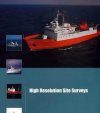![High Resolution Site Surveys High Resolution Site Surveys]()
Click to have a closer look
About this book
Contents
Customer reviews
Related titles
About this book
High Resolution Site Surveys brings together the full range of site surveying techniques for the first time, to provide a unified approach to marine and land-based resolution surveying. Detailed descriptions are given of digital seismic survey methods, hydrographic 'analogue' search and survey tools, non-seismic survey techniques, and positioning systems, including GPS. 'Brite Spot' analysis, and Health and Safety considerations for site surveys are also discussed. Well-illustrated, and with numerous case studies showing the application of theory in everyday situations, High Resolution Site Surveys is an indispensable guide for both the student and practitioner alike.
Contents
Preface. Acknowledgements. Chapter1. Review of the Site Survey Technique. 1.1 Introduction. 1.2 Historical Background. 1.3 High Resolution Seismic Site Surveys. 1.4 Digital Seismic Site Surveys. 1.5 Analogue Site Surveys. 1.6 Sonar Swath Bathymetry. 1.7 Autonomous Underwater Vehicles. 1.8 Remote-Operated Vehicles. 1.9 Environmental Site Survey Techniques. 1.10 Gravity and Magnetics. 1.11 Seismic Refraction. 1.12 Pipeline Surveys. 1.13 Marine Archeological Surveys. 1.14 Positioning Systems. 1.15 Site Survey Grids. 1.16 Project Planning and Preliminaries. 1.17 Survey Vessels. 1.18 Reporting. Chapter 2. High Resolution Digital Site Survey Systems. 2.1 Digital Recording Systems. 2.2 Texas Instruments Digital Field System (DFS) Mk V. 2.3 Sercel SN 358 Digital Recording System. 2.4 TTS-2. 2.5 OYO DAS-1A. 2.6 Geometrics Strativisor NX Seismic Recorder. 2.7 Digital Systems Tests. 2.8 Sparker Seismic Energy Sources. 2.9 High Frequency Seismic Airgun Sources. 2.10 Other Site Survey Seismic Energy Sources. 2.11 Source Fire Control Systems for Site Surveys. 2.13 Onboard Processing. 2.14 Digital Site Survey Interpretation. 2.15 Contractual Work Standards. Chapter 3. Analogue Site Survey Systems. 3.1 Categories of Analogue Systems. 3.2 Echosounders. 3.3 Sidescan Sonars. 3.4 Sonar Swath Bathymetry. 3.5 Autonomous Underwater Vehicles. 3.6 Sub-Bottom Profilers. 3.7 Boomers and Sparker Profilers. 3.8 Multi-Electrode Sparkers. 3.9 Analogue Recorders and Filters. 3.10 Seismic Refraction Survey. 3.11 Site Survey Discussion. Chapter 4. Non-Seismic Site Survey Techniques. 4.1 Gravity Covers and Seabed Sampling. 4.2 Shearvane Penetrometers. 4.3 Vibrocorers. 4.4 Underwater Photography. 4.5 Current Meters. 4.6 Engineering Tests and Cone Penetration. 4.7 Remote Operated Vehicles. 4.8 Gravity Survey. 4.9 Marine Proton Magnetometers. 4.10 Marine Caesium Vapour Magnetometers. Chapter 5. Positioning Systems. 5.1 Introduction. 5.2 Principles of GPS Operation. 5.3 Co-ordinate Systems. 5.4 Geoids, Ellipsoids, Datums and Shifts. 5.5 GPS Differential Mode Principles. 5.6 Real-Time Kinematic (RTK) GPS. 5.7 DGPS Quality Control. 5.10 Supervisory Quality Control Systems. 5.11 Integrated Navigation Systems. 5.12 Acoustic Positioning Systems. Chapter 6. Safety. 6.1 Safety Reviews. 6.2 Documentation. 6.3 Health and Safety Policy. 6.4 Incident and Accident Reporting Policy. 6.5 Cranes and Lifting Gear. 6.6 Working Conditions and Working Practices. 6.7 Fire Protection Equipment. 6.8 Vessel Safety and Survival Equipment. 6.9 Training and Emergency Response Procedures. 6.10 Seismic Operations. 6.11 Electrical Equipment and Emergency Power Supplies. 6.12 Helicopter Operations. 6.13 Personnel Competence Assurance. 6.14 Environmental Monitoring. Glossary and Notation. Index.
Customer Reviews
























